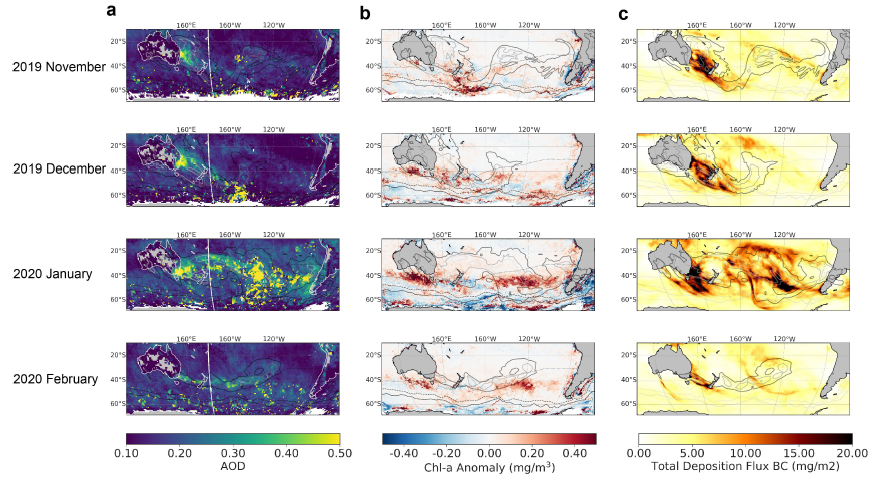Story
Widespread phytoplankton blooms in the Southern Ocean following Australian wildfires
15 September 2021

Aerosol samples originating from the Australian wildfires contained a high iron content. Atmospheric trajectories show that these aerosols were likely to have been transported to the bloom regions, suggesting that the anomalous blooms resulted from the fertilization of the iron-limited waters of the Southern Ocean by the wildfires.
The Southern Hemisphere summer of 2019–2020 saw one of the most severe wildfire seasons in Australian history. Millions of hectares of vegetation were burned, nearly 3 million animals died or were displaced and approximately 178 million tonnes of additional carbon were released, all of which contributed to significant ecological, environmental and socio-economic impacts.
Climate models forecast more frequent and severe wildfires in many regions, and therefore a greater appreciation of the links between wildfires, aerosols, nutrient cycling and marine photosynthesis is important in understanding possible future scenarios for our global climate system. Extensive measurements of wildfire aerosols and targeted studies of their effects on marine ecosystems are also needed to further clarify the full range of impacts.
PML’s contribution to this fascinating study included: providing processed satellite data, via the European Space Agency’s Ocean Colour Climate Change Initiative project, and contributing expert knowledge to the interpretation of the chlorophyll timeseries, such as the lifecycle of the bloom event, the impact of aerosols on ocean colour signals and the validation against in-situ data from autonomous data collection devices.
Dr. Shubha Sathyendranath, Merit Scientist at PML, commented: “This work illustrates how complex our climate system is: the Australian wildfires affected not just the local terrestrial ecosystem, but also the marine ecosystem thousands of miles away, via the atmosphere, which carried the ash to distant locations.”
Dr Thomas Jackson, Ocean Colour Scientist at PML, added: “It was an honour to work with this group of international scientists on such an interdisciplinary problem, with each one bringing their expertise to put the whole story together. The phytoplankton response to the fallout of the Australian wildfires was impressive in terms of both its geographical extent and the magnitude of the anomaly. Phytoplankton have long been considered sentinels of change, responding at both short and long timescales to changes in the physical and chemical state of the oceans. It will be interesting to see if ‘megablooms’ such as these become more common, and what the ecological impacts of such blooms could be, as wildfires and other extreme environmental events become more frequent as a result of climate change.”
The study was funded by the Australian Research Council, AXA Research Fund, French government and the Harry H. Hess Postdoctoral Fellowship and involved scientists from PML, Duke University, University of Tasmania, Barcelona Supercomputing Centre, Woods Hole Oceanographic Institution, Princeton University, CSIRO Oceans and Atmosphere and the University of Brest.